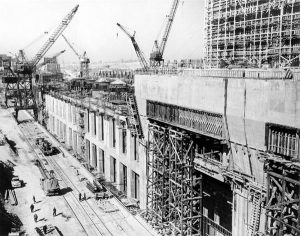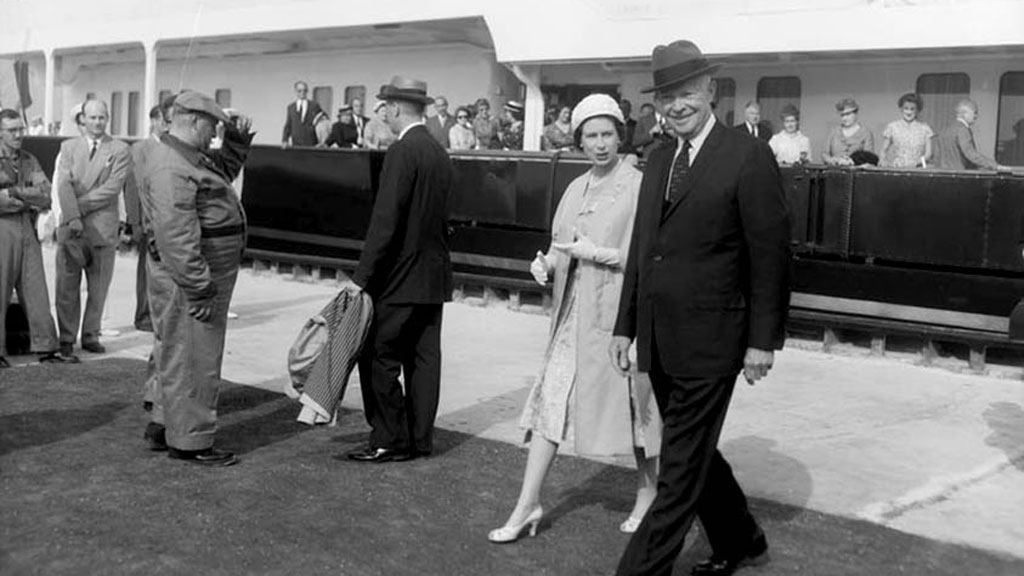In honour of Queen Elizabeth II’s funeral today (Sept. 19), The Daily Commercial News and Journal of Commerce are featuring coverage of the opening of the St. Lawrence Seaway in Canada in 1959 as well as what the seaway means to Canadians since the bow of the royal yacht Britannia broke the “golden ribbon.”

It seems a relic of a bygone era.
Seaway Awaits Queen is the title of a 1959 newsreel from British Pathe that offers insights into how the world viewed the opening of the St. Lawrence Seaway on June 26 of that year.
Queen Elizabeth II, in the seventh year of her reign, said goodbye to family members and waving subjects on the tarmac at London Airport before boarding a Comet IV plane for Canada.
“Godspeed Your Majesty,” the newsreader intones, observing that the Queen was leaving with the “assurance of a truly royal welcome in friendly Canada.”
The ceremony overseen by the Queen and U.S. President Dwight Eisenhower took place with 20,000 in attendance at St. Lambert Lock at Montreal, one of seven built in the precinct. The bow of the royal yacht Britannia broke a “golden ribbon” and the seaway was “officially and royally declared open.”
“What a tribute it all is to Canadian vision and enterprise, helped by U.S. co-operation,” the newsreader says over images of the project. “The free world heralds a stupendous achievement.”
In 1954, the U.S. and Canadian governments had passed legislation to proceed with the seaway – the Americans finally convinced in part by the addition of extensive power projects to the package. The cost would be $470.3 million, of which Canada paid $335.5 million.
Canada would also pay a further $300 million to improve the Welland Canal.

New lift bridges at each end of the St. Lambert Lock gave the 120-foot clearance necessary for ocean-going ships, which could now venture “into the very heart of the continent…The old dream is fulfilled of a highway for ships from Duluth at the head of Lake Superior to the Gulf of St. Lawrence 3,000 miles away,” the announcer states.
In her address, the Queen called the project “one of the outstanding engineering accomplishments of modern times.”
Sixty-three years later, the world views such projects through a broader lens.
Asked for his recollection of the project, retired Canadian economist and farmer Robert Campbell recalled how the environmental impacts of major projects of that era were mainly the subject of conversation among university professors and “people with their heads in the clouds.”
He was a fresh graduate of the University of Western Ontario when the project got underway and became employed by a consulting firm, KCS, the year the seaway opened.
“There were large engineering projects like the seaway that certainly caught the attention of the public and the politicians but little thought was being given to the impact they could have on the natural economy,” said Campbell.
“All the attention was on what would serve us cheaply, most economically and fastest.”
Economists soon learned there were many unforeseen consequences of the disruptive infrastructure. What the seaway was missing in those early years, Campbell said, was a central operating system.
Campbell’s firm was called in to offer solutions to significant shipping traffic jams at the Welland Canal, where eight locks lift ships 99 metres at the Niagara escarpment. Campbell said haulage of raw materials such iron ore and wheat on large ships was proceeding as planned but it appeared project designers did not anticipate a steep increase in smaller vessels carrying general cargo of higher value, such as cars, refrigerators and radios.
“One characteristic of traffic issues is, if you have any choke point or area of restriction, this causes what’s called a queuing problem,” he explained. “A little loss of time at the choke point can be amplified.”
One solution offered by KCS was better co-ordination of Welland Canal lockmasters – including the purchase of Timex watches so they could work in better synch, Campbell said.
Time-lapse photography was also used to track co-ordination problems.
Meanwhile, the ports at Halifax and Saint John, N.B. were being threatened with loss of business as fewer ocean-going ships had to unload on the coast. Campbell said Halifax was in a good position with its access to an extensive network of rail lines and he advised that the introduction of container shipping, then being launched on the West Coast, could increase loading efficiencies tenfold. Containers were soon adopted.

History records that in 1958, nine villages in eastern Ontario were purposely submerged to accommodate new power infrastructure. Campbell, raised in southern Ontario and now a resident of Edmonton, said the environmental degradation could have been worse. At one point the St. Lawrence Seaway Management Corporation was considering a huge expansion.
“The seaway involves so much change in channels that there was a real concern of what this would do to the flow and levels of lake water in the system. In other words, the whole ecology,” he said.
Campbell said Lakes Huron and Erie could have been irreparably altered.
Summing up the lack of awareness of the environmental and even industrial consequences at the time, Campbell said simply, “With hindsight you would do a lot of things differently.”
Campbell has crossed paths with royalty several times in his life and once sat at a table at a dinner with the Queen Mother. He considers himself a “soft royalist.”
Under Queen Elizabeth, Campbell said, the monarchy was “a stabilizing influence. The role of royalty in one way has been to separate the symbolic from the practical,” with the monarchy able to stay above “dirty politics.”











Recent Comments